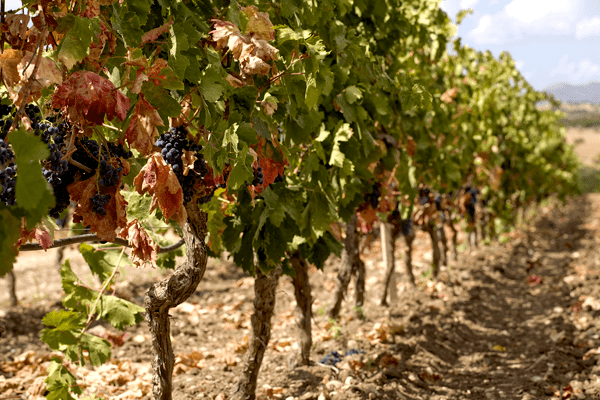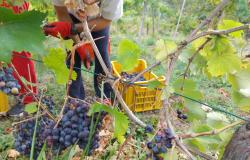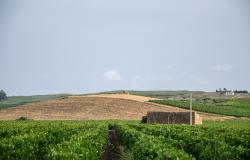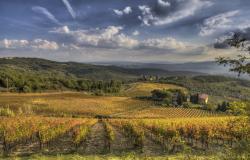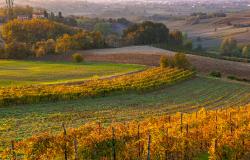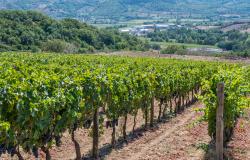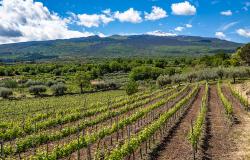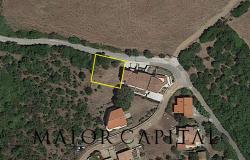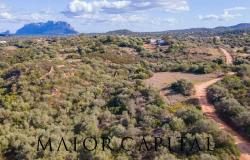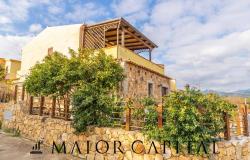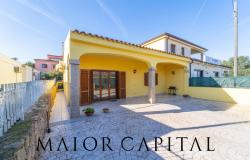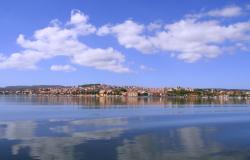Like tiny soldiers standing on attention, tidy rows of perfectly trimmed vines climb up a gentle hill, emerald against a baby blue sky. A soft breeze barely rustles through the leaves. And here and there, glimpses of turquoise appear among the ripening bunches—distant views of the sea that shaped this land, its vineyards and its grapes.
It is easy to see why Sardinia earned the moniker of insula vini, wine island, in the 16th century. A mild climate, plenty of good limestone and fragmented granite soils, and a dozen indigenous grape varieties all conspired to make it one of the Middle Ages’ vinous landmarks.
In the twentieth century, however, cooperative wineries, which were the island’s largest producers, started buying shareholder grapes at a guaranteed price per quintal delivered—regardless of quality. As a result, a culture of high yields, shoddy viticulture and low winemaking standards became widespread and ultimately compromised the local wine industry.
With a few notable exceptions, such as high quality winemaker Sella & Mosca in Alghero, Sardinia acquired a reputation for producing cheap plonk with high alcohol content—a byproduct of scarce water and hot summers. Few people liked the stuff and, as soon as the market for loose wine declined, many businesses went bust and the number of acres under cultivation decreased. Until the early 1990s, that is—then everything changed.
In the last years of the last century, a number of enlightened winemakers engendered an unprecedented Renaissance that has now propelled the island to vinous stardom. People like Pepetto and Franco Argiolas in Serdiana, the Alberto Loi family in Cardedu, the Ragnedda brothers in Arzachena, Giovanni Maria Cherchi in Usini, and even some coop wineries, including the one in Santadi and the one in Tempio, wrought dramatic changes, sometimes despite workers resistance and shareholders opposition.
People like Pepetto and Franco Argiolas in Serdiana, the Alberto Loi family in Cardedu, the Ragnedda brothers in Arzachena, Giovanni Maria Cherchi in Usini, and even some coop wineries, including the one in Santadi and the one in Tempio, wrought dramatic changes, sometimes despite workers resistance and shareholders opposition.
Starting from the assumption that good wine starts in the vineyard, they drastically reduced yields and improved cultivation, picking and winemaking methods; they adopted modern techniques and technologies, but blended them with traditional methods and indigenous varieties; they sought the help of top Italian oenologists such as Giacomo Tachis, but weren’t afraid to celebrate local flavours, aromas and individuality—and ended up with a crop of exceptional wines. So much so that it is hard to recommend any one of Sardinia’s Renaissance bottles over the others, because they are all worth trying.
However, we turned ultra-selective and picked six (three reds and three whites) that, in our view, really embody the taste of the island.
Red wines
1. Turriga, Cantine Argiolas
 Franco and Pepetto Argiolas led Sardinia’s wine revolution in the 1990s. Persuaded that the only way to be competitive was for Sardinia to produce vinous gems, they set out to do just that.
Franco and Pepetto Argiolas led Sardinia’s wine revolution in the 1990s. Persuaded that the only way to be competitive was for Sardinia to produce vinous gems, they set out to do just that.
They expanded their family vineyards across the limestone and granite hills of Serdiana, started bottling their own production and called upon the expertise and fine palate of top oenologist Giacomo Tachis.
Together, they developed Turriga, the Argiolases flagship wine and the Koh-I-Noor of the island’s wine jewels. Turriga is a sultry blend of Sardinia’s most interesting grape varieties—Cannonau, Carignano, Malvasia Nera, and Bovale Sardo. Aged in French oak for 18 to 24 months, then in bottle for another 12-14, it is a powerful, ruby red with notes of plum and berries and a very long finish.
Perfect with wild boar stew, game, spicy red meat dishes and aged pecorino cheese.
2. Terre Brune, Cantina di Santadi
 Santadi started life as a regular cooperative winery—but attention to quality and an enlightened management soon turned it into a shining example of both great winemaking and serious grape conservation.
Santadi started life as a regular cooperative winery—but attention to quality and an enlightened management soon turned it into a shining example of both great winemaking and serious grape conservation.
The coop revived the fortunes of an indigenous variety, Carignano del Sulcis, which is a (tastier) clone of French Carignan. Perfectly suited to Santadi’s sand and limestone soils, it soon made its way into what became the coop’s top wine, Terre Brune.
Made with Carignano with a small addition of Bovaleddu, Terre Brune is one of the first Renaissance wines to be produced on the island and, fittingly, it tastes like Sardinia in a bottle.
It is an intense wine full of red fruit, spice, vanilla with just a hint of sun-drenched herbs. Aged in French oak for 16 to 18 months, then in bottle for a year, it is great with roasts, grilled meat, game and blue cheese.
3. Alberto Loi Riserva, Alberto Loi
 Oenologist Sergio Loi of the Alberto Loi winery in Cardedu had to fight long and hard to persuade his employees to prune the vines as much as he wanted. His idea of reducing yields just ran counter to received wisdom.
Oenologist Sergio Loi of the Alberto Loi winery in Cardedu had to fight long and hard to persuade his employees to prune the vines as much as he wanted. His idea of reducing yields just ran counter to received wisdom.
But the effort was well worth it because today the Loi winery makes some of the very best Cannonau in Sardinia.
Cannonau is the island’s most established and representative variety, and the company plays it to perfection, particularly in the elegant Alberto Loi Riserva, a powerful, full-bodied but austere red with hints of cherries and plums.
First aged in Slavonian oak barrels for up to 14 months, then in French oak for four and in bottle for eight to ten months, it goes perfectly with aged cheeses, rich meat dishes and game.
White wines
1. Tuvaoes, Giovanni Cherchi
 Go to Usini, ask for Cherchi and everyone will direct you to ‘Tiu Billia’ (uncle Billia)’s vineyard, high on a hill.
Go to Usini, ask for Cherchi and everyone will direct you to ‘Tiu Billia’ (uncle Billia)’s vineyard, high on a hill.
The nickname is testament to the fact that the Cherchis remain an unassuming family with an easy manner, even though they have joined the ranks of the vinous great and good.
The wine that pushed them into the limelight is Tuvaoes, a rich, elegant, impossibly aromatic Vermentino. As soon as it hit the wine counters some fifteen years ago, it took the world by storm, with critics like gastronomy bible Gambero Rosso giving it great praise.
Today Tuvaoes still deserves its cult status. Round and perfectly balanced, it manages to be both rich and fresh with notes of fruit and almond and a long long mouth. Ideal with fish.
2. Capichera, Capichera
 Vermentino also reigns supreme at the Ragnedda brothers’ estate, Capichera. From the most panoramic vineyard in Sardinia—it overlooks the Porto Cervo gulf—comes one of the most idiosyncratic Vermentinos and one of the first great whites produced on the island.
Vermentino also reigns supreme at the Ragnedda brothers’ estate, Capichera. From the most panoramic vineyard in Sardinia—it overlooks the Porto Cervo gulf—comes one of the most idiosyncratic Vermentinos and one of the first great whites produced on the island.
Surprisingly for this kind of wine, it is aged in barrique, which gives it great intensity and complexity. Straw yellow in the glass, it hits the nose with notes of orange blossom, rosemary and thyme, and evolves in the mouth with a perfect balance of acidity and sweetness, citrus fruit and minerals.
Great with fish, shellfish and seafood risottos.
3. Canayli, Cantina Gallura
 As a cooperative winery, the Cantina Gallura had its work cut out when it switched to low yields and better viticultural practices.
As a cooperative winery, the Cantina Gallura had its work cut out when it switched to low yields and better viticultural practices.
Initially, growers’ opposition was loud and strong, but it fizzled into nothingness as soon as the local wines started selling like hot cakes.
The region of Gallura, where the coop is situated, is ideal for growing Vermentino, and the Cantina has made an extraordinary use of the local grape. Its Vermentino Superiore di Gallura Canayli is an aromatic white with a traditional feel and contemporary elegance.
Straw yellow in the glass, it has notes of green pepper and a lovely almost-bitter finish. Structured but fresh, it is also priced very competitively. The perfect wine for an easy summer dinner, it works well with seafood risottos and grilled fish.
